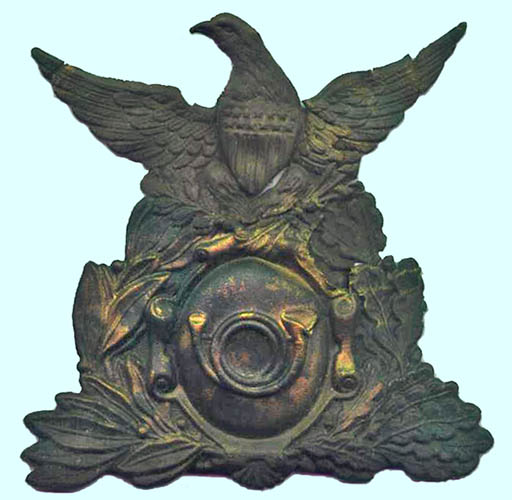U.S. Plate for French Shako

U.S. Plate for French Shako
Excavated at Brandy Station, Virginia

In the middle of the 19th Century the leading nation in military fashion was France. Emperor Napoleon III led a resurgent France, reaching yet again for the glory of the era of Napoleon I. In the end this resurgence fizzled with defeat in the Franco-Prussian War of 1870.
The American military was highly influence by the French and many delegations were sent to France study developments. The regulation American uniform adopted in 1851 was greatly influenced by French military fashion. With the outbreak of the Civil War the Quartermaster Department did not have the stores to equip all of the volunteer troops with uniforms. States were asked to assume part of the responsibility. In addition, it appears consideration was given to foreign sources. Secretary of War Simon Cameron was sent a catalog of the French uniform manufacturing firm of Alexis Godillot by the American Legation in France and it was decided to order 10,000 uniforms based on the French Chasseurs à pied pattern. The term Chasseur is French for hunter and à pied indicates on foot rather than mounted. These troops were used as skirmishers and light infantry.
WAR DEPARTMENT, QUARTERMASTER-GENERAL'S OFFICE,
Washington, D.C., August 9, 1861.
Hon. W. S. PENNINGTON,
Secretary of Legation, Legation United States, Paris:
DEAR SIR: The Secretary of War has referred to this office the book of Photographs of Military Equipments manufactured at the establishment of M. Alexis Godillot, at Paris, which you obligingly sent to the War Department.
Will you request our minister at Paris to order of M. Godillot, provided it can be done at the prices paid by the French Government, a Complete equipment for 10,000 men. These men to be uniformed as the chasseurs à pied, to be supplied with regulation knapsacks and all other articles of equipment, including tente abri, officers' tents, council tent, &c.
The organization of the 10,000 men to be according to that of Orders, No. 15, for volunteer infantry in ten regiments, inclosed.
All these equipments to be shipped to this country at the earliest possible date, consigned to the Quartermaster-General of the United States, and as imported for the United States free of duty.
The carts and ambulances are not desired. The medicine chests and packs, cacolets, and mule litters should be included in the contract.
Clothing for commissioned officers and arms are not included in this order, which relates to clothing and camp equipage for the enlisted men and non-commissioned officers only, and tents for the commissioned officers of ten regiments of infantry.
Upon being advised of the cost of this equipment, money will be placed at Baring Bros., or the draft of the American minister upon the Quartermaster. General of the United States will be honored on presentation.
M. C. MEIGS,
Quartermaster. General.
It appears that the legation was assisted by George L. Schuyler of the firm of Schuyler, Hartley and Graham, a major military outfitter who was in France arranging importation of European weapons. Schuyler wrote in a September 5, 1861 letter to Simon Cameron:
"I have been assisting Mr. Dayton, our minister, principally as interpreter, in closing his contracts for the clothing, equipment, &c., of 10,000 men--Chasseurs de Pied de la Ligne. The contract was closed yesterday, amounting to about $500,000, and the whole will be shipped by steamer of October 16. It was necessary to stipulate for clothing of a larger size, as most of these Frenchmen are more like boys in height, though tolerably broad shouldered.
You will please excuse the length of this communication, but as it embraces all I have to say upon general subjects connected with arms, in future my notes will be shorter.
With much respect, your obedient servant,
GEORGE L. SCHUYLER."
The uniforms arrived in the United States with Monsieur Godillot, who unsuccessfully sollicited additional contracts. They were issued to the 62nd and 83rd Pennsylvania and 18th Massachusetts Infantry Regiments. Schuyler's comment regarding the French being built smaller than Americans quickly became a major problem. Too many of the uniforms were too small and tight fitting. In the end the units returned the clothing to the Quartermaster Department late in 1861.
It appears that following their return the uniforms were issued a second time in the fall of 1862 to part of the Excelsior Brigade (70th, 71st, 72nd, 73rd, and 74th New York Infantry Regiments), originally recruited and led by Daniel Sickles. The above shako plate was one of many discovered discarded in a camp occupied by the Excelsior Brigade near Brandy Station, Virginia in the fall of 1863. It can only be assumed that the regimental quartermaster either discarded some of the shakos or just the plates at that time. Both the 73rd and 74th New York were originally outfitted in American-made Chasseur dress. A number of American units chose to imitate Chasseurs rather than their better known cousins the Zouaves. There is some logic that the Quartermaster Department would have chosen to issue them the returned Chasseurs à pied uniforms since there was an effort to issue special clothing to Zouave and Chasseur units that had previously adopted non-regulation uniforms.
In addition to the Excelsior Brigade some of the shakos, but not the uniforms were issued to the band of the Veteran Reserve Corps in Washington, D.C. Other shakos were sold as surplus and then sold by outfitters to civilian bands during the postwar period.